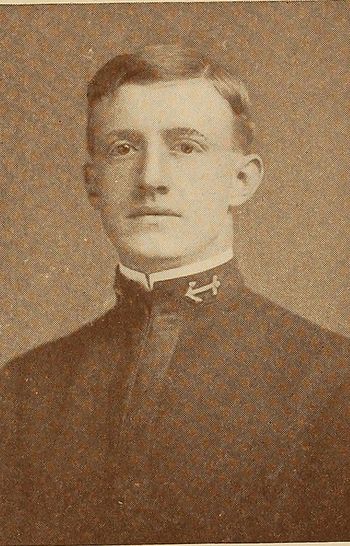WILLIAM P. WILLIAMSON, LCDR, USN
William Williamson '07
Lucky Bag
From the 1907 Lucky Bag:
WILLIAM PRICE WILLIAMSON
Winona, Minnesota
A silver-tongued confidence man, who believes in learning by experience. Has a coquettish way of burying a cigarette in his neck and talking around the smoke. Discovered that water and sulphuric acid are bad for the complexion. Believes in being picturesque, but condescends to wear working clothes occasionally since he tried to navigate a capsized canoe in full dress. Has dates with Mattie three weeks ahead and does a little promiscuous fussing on the side. An unappreciated peacemaker and responsible for the resurrection of n + 1 antediluvian jokes (?) a day. For further details of his career see the history of Citizen Fixit in the Sunday papers. A doctor of note.
P. O. First Class.

WILLIAM PRICE WILLIAMSON
Winona, Minnesota
A silver-tongued confidence man, who believes in learning by experience. Has a coquettish way of burying a cigarette in his neck and talking around the smoke. Discovered that water and sulphuric acid are bad for the complexion. Believes in being picturesque, but condescends to wear working clothes occasionally since he tried to navigate a capsized canoe in full dress. Has dates with Mattie three weeks ahead and does a little promiscuous fussing on the side. An unappreciated peacemaker and responsible for the resurrection of n + 1 antediluvian jokes (?) a day. For further details of his career see the history of Citizen Fixit in the Sunday papers. A doctor of note.
P. O. First Class.
Loss
William was lost on August 17, 1918 when a depth charge exploded on the deck of USS Orizaba (ID 1536) during testing of a throwing device. He was the ship's executive officer.
Other Information
From Wikipedia:
William Price Williamson was born in Norfolk, Virginia on August 10, 1884, the son of Thom and Julia Price Williamson. He grew up near Washington D.C. and, after graduation from Western High School there, was appointed midshipman on June 29, 1903, and graduated from the Naval Academy with the class of 1907, in the advanced section of that class, on September 12, 1906. Assigned to Indiana (Battleship No. 1), he landed from that ship at Kingston, Jamaica, in January 1907 and was cited by his commanding officer for his efficient work in a rescue party during fires resulting from an earthquake there.
Williamson later joined Kansas (Battleship No. 21) and made the globe girdling cruise of the Great White Fleet (1907–1908) before he was ordered to Washington, D.C., in March 1909 for "ordnance instruction". From there, he went to Utah (Battleship No. 31) in October 1911. While in that dreadnought, he commanded the gun battery of Utah's landing force during the landings at Veracruz, Mexico, in April 1914.
Williamson inspected ordnance at the E. W. Bliss and Co., Brooklyn, New York, from 1914 to 1916 before he joined Galveston (Cruiser No. 17) on May 13, 1916, for a brief tour of duty. He then journeyed to the Asiatic Station to become the Inspector of Ordnance and Powder at the Naval Magazine and Chemical Laboratory in Olongapo in the Philippines (later called the Naval Ammunition Depot, Olongapo) on July 7, 1916.
Returning to the United States in the spring of 1918, he was assigned duty assisting in the fitting out of USS Orizaba (ID 1536) and became the ship's first executive officer when that transport was commissioned. Williamson then worked closely with the ship's commanding officer, Captain R. Drace White—another ordnance expert—in developing a workable depth charge thrower for use on board transports, in the hope of providing them with some measure of protection of their own. Williamson's invention was a modified Lyle gun (one used for line throwing in rescue operations). In the first test on August 16, 1918, the crude depth charge projector hurled a 50 pound charge approximately 150 feet.
However, before using their creation in actual operations against submarines trailing her convoy, the two officers wanted at least one more test with a larger propellant charge. Accordingly, on August 17, 1918, they commenced another experiment—which proved to be a disaster.
Williamson fired the gun, but a defective fuse caused the depth charge to explode prematurely, killing him instantly. The blast knocked Capt. White to the deck (with a broken jaw, broken knee, and flesh wounds), and killed three sailors. In addition, four other officers and 22 other enlisted men were wounded in the tragic explosion. For his work, however, Williamson was awarded the Navy Cross posthumously.
William Price Williamson was the grandson of Confederate Chief Engineer William Price Williamson of North Carolina. Confederate Chief Engineer Williamson has been credited with first suggesting that the hull of the USS Merrimack could be used to build the Confederate ironclad CSS Virginia.
From researcher Kathy Franz:
William married Florence Beam in 1911. She lived at 280 Madison Ave., New York City.
His father was Rear Admiral Thom Williamson, pioneer officer of the Navy, who served on the staff of Admiral Farragut in the Civil War. He died in March 1918, after returning from the Philippines. William's mother was Julia, and he had one brother Thom and five sisters.
He was survived by his wife, mother, and two sisters. He is buried in Arlington National Cemetery.
From Hall of Valor:
The President of the United States of America takes pride in presenting the Navy Cross (Posthumously) to Lieutenant Commander William Price Williamson, United States Navy, for exceptionally meritorious and distinguished service in the line of his profession on duty on the U.S.S. ORIZABA. Lieutenant Commander Williamson lost his life on 17 August 1918, when a depth bomb exploded on board the U.S.S. ORIZABA.
Service: Navy
Division: U.S.S. Orizaba
Namesake
USS Williamson (DD 244) was named for William; the ship was sponsored by his widow.
The "Register of Commissioned and Warrant Officers of the United States Navy and Marine Corps" was published annually from 1815 through at least the 1970s; it provided rank, command or station, and occasionally billet until the beginning of World War II when command/station was no longer included. Scanned copies were reviewed and data entered from the mid-1840s through 1922, when more-frequent Navy Directories were available.
The Navy Directory was a publication that provided information on the command, billet, and rank of every active and retired naval officer. Single editions have been found online from January 1915 and March 1918, and then from three to six editions per year from 1923 through 1940; the final edition is from April 1941.
The entries in both series of documents are sometimes cryptic and confusing. They are often inconsistent, even within an edition, with the name of commands; this is especially true for aviation squadrons in the 1920s and early 1930s.
Alumni listed at the same command may or may not have had significant interactions; they could have shared a stateroom or workspace, stood many hours of watch together… or, especially at the larger commands, they might not have known each other at all. The information provides the opportunity to draw connections that are otherwise invisible, though, and gives a fuller view of the professional experiences of these alumni in Memorial Hall.
July 1907
January 1908
January 1910
January 1911
January 1912
January 1913
January 1914
January 1915
January 1916
January 1917
March 1918

The "category" links below lead to lists of related Honorees; use them to explore further the service and sacrifice of alumni in Memorial Hall.